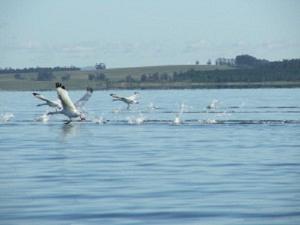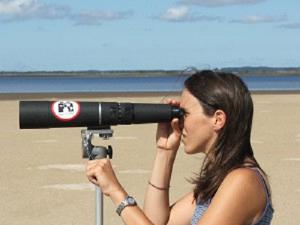Macarena Sarroca
This project will allow us to identify the most important feeding areas of the Laguna De Rocha and explain how the feeding habitats affect the distribution of Black-necked Swan and the Coscoroba Swan.

Coscoroba Swans, a group of Coscoroba Swans taking off at Laguna de Rocha. ©Macarena Sarroca.
Bañados del Este Biosphere Reserve (MaB/UNESCO) (200,000 ha) in Uruguay is part of a larger complex of wetlands extending into southern Brazil, and includes several ecoregions of outstanding global value. This area is composed of a mosaic of habitats, including mudflats, coastal dunes, estuaries, rivers, coastal wetlands and coastal lagoons, inland marshes, palm swamps, grasslands, and riparian habitats.

Bird count, Macarena counting swans at “Bolsón de los Noques”, a large embayment in the west coast of Laguna de Rocha. ©Carolina Abud.
Laguna de Rocha is part of this ecosystem and its connection to the sea through its sand bar dynamic results in high habitat heterogeneity and biodiversity. Laguna de Rocha is being proposed as a Protected Area to be included in the Sistema Nacional de Áreas Protegidas - SNAP (National System of Protected Areas) due to its importance as a stop-over area for migratory birds, including 19 species of shorebirds and 21 species of waterfowl, and its global ecological and biological value.
The committee in charge of elaborating the management plan for the lagoon has no funds to collect field data about the present situation of the birds. Moreover, there is a reduced amount of information on waterbird ecology in Uruguay. The Black-necked Swan and the Coscoroba Swan are endemic of the Neotropic Region, in Uruguay both species are resident and the largest abundances have been recorded at Laguna de Rocha. Both species have conservation problems and in Chile, the Black-necked Swan is considered “Vulnerable”. As a master student in Ecology I decided to undertake a thesis that would give an input of information to the management plan of the lagoon considering waterbirds. This project will be important to asses the conservation of these birds and their habitat.
I will study the distribution of the swans in the lagoon thru aerial census, boat and ground counts. I will also study the plant and invertebrate distribution in the lagoon to describe the feeding habitat selection of the swans. This project will allow us to identify the most important feeding areas of the lagoon and explain how the feeding habitats affect the distribution of the swans. In addition we will compare the distribution between both swan species. The results of this project will be presented to the committee with the responsibility of elaborating the management plan in order to incorporate specific guidelines for the waterbirds of the lagoon.